THE VAMPIRE LOVERS: Old Guard Meets Modern Sex At The Hammer Horror Show
The unspoken appeal of Hammer Films' classic output of the mid-'50s to the '60s is that it was always riding the line of what the horror genre could bear in terms of explicitness. Beyond the fun of watching pros like Peter Cushing and Christopher Lee at work, you could always count on these films for the occasional splash of stage blood that you'd never see in a Universal horror film. There was also the appeal of how the female cast members' costumes were designed to highlight the cleavage of their heaving bosoms during the all the on-screen frights.
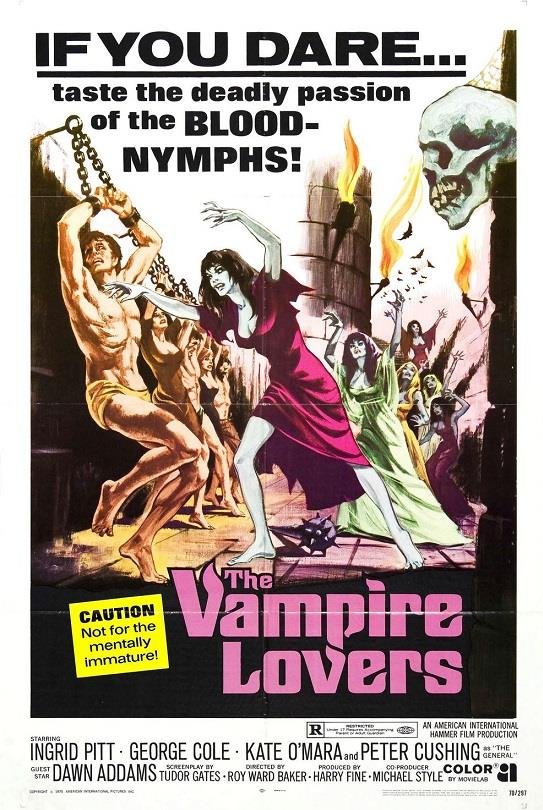 However, the rising tide of cinematic freedom at the dawn of the '70s called for more than winks and nods at graphic shocks. Filmmakers all over the world were pushing hinted-at horror and eroticism into the open in ways that made Hammer's output suddenly look quaint. Thus, Hammer was forced to step up its game and pursue a more adult flavor of gothic horror. Their first entry into this evolution of their style was The Vampire Lovers, a lesbian-themed vampire film that represented an intriguing mixture of the old guard and the new wave.
However, the rising tide of cinematic freedom at the dawn of the '70s called for more than winks and nods at graphic shocks. Filmmakers all over the world were pushing hinted-at horror and eroticism into the open in ways that made Hammer's output suddenly look quaint. Thus, Hammer was forced to step up its game and pursue a more adult flavor of gothic horror. Their first entry into this evolution of their style was The Vampire Lovers, a lesbian-themed vampire film that represented an intriguing mixture of the old guard and the new wave.
The script derives its basis from "Carmilla," a J. Sheridan LeFanu tale that would inspire many a lesbian vampire film during the '70s. It's central figure is "Marcilla" Karnstein (Ingrid Pitt), a sort of vampire grifter who travels from town as she takes victims, 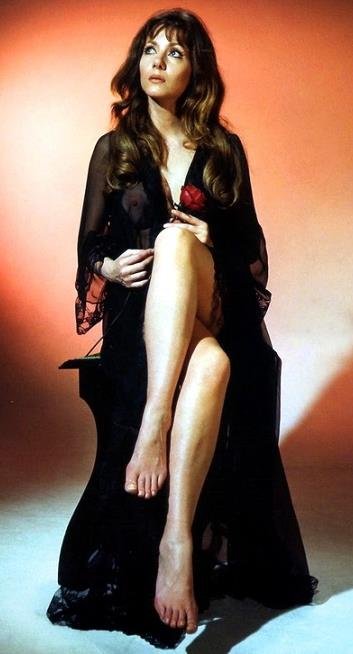 usually female. The first act establishes her modus operandi of working her way into an upper-class household with a nubile young victim she can toy with - in this case, the home of General Von Spielsdorf (Cushing) and his daughter, Laura (Pippa Steele). Laura falls under Marcilla's spell and is slowly bled to death over a series of nights.
usually female. The first act establishes her modus operandi of working her way into an upper-class household with a nubile young victim she can toy with - in this case, the home of General Von Spielsdorf (Cushing) and his daughter, Laura (Pippa Steele). Laura falls under Marcilla's spell and is slowly bled to death over a series of nights.
Before anyone can suspect anything, Marcilla is off to the next posh home and posing as "Carmilla" this time. Her new target is Laura's best friend, the young and impressionable Emma (Madeline Smith), with her Governess (Kate O'Mara) as a secondary 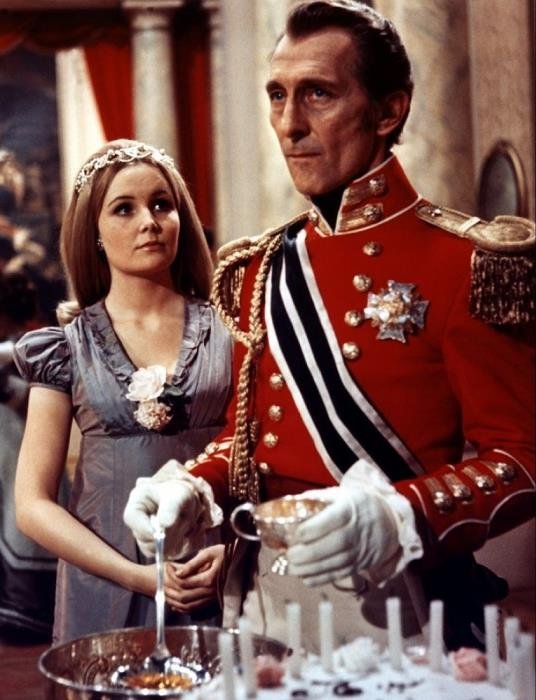 target. She begins to ply her trade but fate is closing in on her: the grieving General teams up with Von Hartog (Douglas Wilmer), who knows a thing or two about the cursed Karnstein clan, to figure out the cause of his daughter's death. She also has to contend with Carl (Jon Finch), a suitor of Emma's, and Renton (Harvey Hall), a butler who is wisely suspicious of Ms. Karnstein.
target. She begins to ply her trade but fate is closing in on her: the grieving General teams up with Von Hartog (Douglas Wilmer), who knows a thing or two about the cursed Karnstein clan, to figure out the cause of his daughter's death. She also has to contend with Carl (Jon Finch), a suitor of Emma's, and Renton (Harvey Hall), a butler who is wisely suspicious of Ms. Karnstein.
The end result is a gothic romp given added spice by the occasional severed head or bit of nudity. Screenwriters Harry Fox, Tudor Gates and Michael Style provide an eventful narrative that maintains the gothic horror conventions while also cranking them up a bit. Director Roy Ward Baker was an old hand at Hammer and his filmmaking approach is more workmanlike than 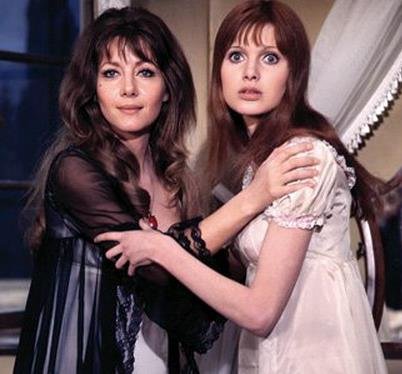 stylish but he maintains a pretty cracking pace throughout the involved storyline. His efforts are aided nicely by the ace craftsmanship of the studio's crew: art director Scott MacGregor provides suitably atmospheric sets and Harry Robinson's musical score has an overripe melodic approach that fits the story's tragic/romantic mood.
stylish but he maintains a pretty cracking pace throughout the involved storyline. His efforts are aided nicely by the ace craftsmanship of the studio's crew: art director Scott MacGregor provides suitably atmospheric sets and Harry Robinson's musical score has an overripe melodic approach that fits the story's tragic/romantic mood.
However, the real show here comes from the acting. Ingrid Pitt is stunning visually - she's voluptuous enough to make Russ Meyer do a double take - but what's really impressive is the vigor she applies to her performance. She invests her character with plenty of melodramatic intensity, her best moment being her anguished reaction to a funeral procession 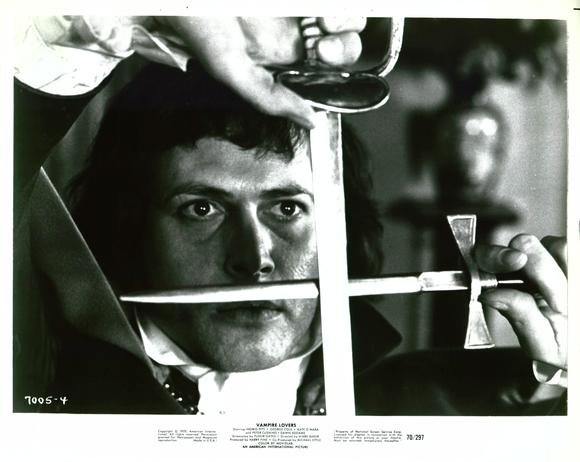 (and the reminder of mortality that it provides). Smith's doe-eyed, waifish beauty is a perfect visual contrast to Pitt and her breathy, underplayed take on the damsel-in-distress archetype is genuinely charming. Cushing seals the film's appeal by providing the marquee name and a classy, old-fashioned display of horror actor chops to balance out the film's saucy style.
(and the reminder of mortality that it provides). Smith's doe-eyed, waifish beauty is a perfect visual contrast to Pitt and her breathy, underplayed take on the damsel-in-distress archetype is genuinely charming. Cushing seals the film's appeal by providing the marquee name and a classy, old-fashioned display of horror actor chops to balance out the film's saucy style.
Overall, The Vampire Lovers remains a fun, sexed-up take on the vampire tale. It's not the best of Hammer's "sexy vamp" films of the '70s - that honor probably goes to Twins Of Evil - but its blend of vintage craftsmanship and '70s eroticism still packs a kick for those fascinated by the evolution of gothic (and erotic) horror filmmaking.


